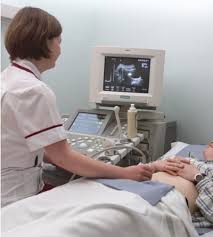Nitrazine (pH)
| NITRAZINE TEST |
Technique:
Amniotic fluid is alkaline and turns Nitrazine pH indicator blue
Accuracy:
False positive results are up to 17.4%
False negative results are 12.9%
Sensitivity 90.7%
Specificity 77.2%
Drawbacks:
Speculum exam is required to collect the sample. False-positive results may be caused by cervicitis, vaginitis (bacterial vaginosis or Trichomonas), alkaline urine, blood, semen, or antiseptics.
***********************************************************************
Ferning
: Technique
Technique
Arborization pattern (crystallization) of dry amniotic fluid as seen through a microscope
Accuracy:
False positive results are 5-30%
False negative results are 12.9%
Sensitivity 51.4% (no labor)
Specificity 70.8% (no labor)
Drawbacks:
Speculum exam is required to collect the sample. Requires microscope. False positives may result from contamination of slide with fingerprints or contamination with semen and cervical mucus. False negative may be caused by dry swabs, contamination with blood and discharge. Lack of certified personnel available on the L&D floor to read the slides or the lab’s requirement to have the slides sent down to the lab.
***********************************************************************
| VAGINAL POOLING |
VAGINAL POOLING
Technique:
Visualization of an amniotic pool in the posterior fornix of the vagina
Accuracy:
Subjective
Drawbacks:
Speculum exam is required. Subjective. Urine, semen, and other fluids can easily be mistaken for amniotic fluid and vice versa.
***********************************************************************
Ultrasound
: Technique
Technique
Ultrasound can detect oligohydramnios, suggesting loss of amniotic fluid due to membrane rupture
Accuracy:
Not a reliable screening test if used alone. Used only to help confirm diagnosis
Drawbacks:
Time-consuming. Requires equipment and expertise. Can only detect significant loss of amniotic fluid. Can’t confirm cause of fluid loss. Not all hospital facilities have ultrasound expertise easily accessible on a 24/7 basis.
***********************************************************************
Amnio-Dye Infusion
Technique:
Instillation of dilute indigo carmine into the amniotic cavity and confirmation of rupture of membranes by documenting leakage of dye into the vagina (staining of tampon) within 20-30 minutes
Accuracy:
"Gold Standard" for diagnosis of rupture of membranes
Drawbacks:
Accurate, but highly invasive (requires amniocentesis). Expensive. Amniocentesis is associated with risk to pregnancy including bleeding, infection, latrogenic rupture of membranes, and loss of pregnancy (approximately 1 in 270).
***********************************************************************
AMNISENSE
AMNIOTIC LEAK DETECTION KIT
Sensitivity: 95.76 Specificity:84.46 |
No invasive procedure require
A single drop of Amniotic fluid is enough for test
Maintain the comfort level of patient and doctors

What is amnisense
ReplyDeletewhat is Amnisense and how its useful as compare to current technique used to detect amniotic fluid
ReplyDeleteAmnisense is the kit which used to detect the amniotic leak during pregnancy
ReplyDeleteThe current technique which are used to detect amniotic leak are invasive and time consuming where as amnisense is not invasive technique and quick result with in 30 min.
Amnisense is an in vitro self-test panty liner that is intended to detect probable leaking amniotic fluid and identify the cause of wetness during pregnancy. Early detection of amniotic leak can help to prevent complications, premature birth, identify a possible membrane rupture and confirm the waters have broken.
ReplyDelete